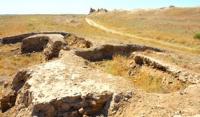You are here
Irrigation tunnel in fortress of Sauran.

Cultural tours from Shymkent to Khiva.
“It so happened that the air in the well deteriorated and it became impossible to work. Then, on one side of the well, they dug a hole the size of a small channel to its depth (well) and passed through the hole something like a sleeve sewn from leather. Blacksmith bellows were attached to the sleeve and the air was pumped, and the master excavators worked. The diggers worked on two pumpkins tied to their hips so as not to drown if the water suddenly clogged with a fountain”
Zayniddin Mahmoud Wasifi - Tajik writer, historian and poet author Badai al-Wakai ”-“ Amazing Events ”- a collection of records of historical, memoirist, epistolary, biographical genres, a description of news and“ miraculous phenomena ”, and also includes several dozens of samples of poetry authorship of Vasifi.
Book travel tours in Shymkent.
There are no rivers or springs in the vicinity of Sauran. Therefore, scientists did not immediately understand where the water came from in this big town. The answer to this question became known thanks to the work of Vasifi.
He describes the unusual water supply of Kazakhstan for the town with the help of kyariz (underground galleries) through which underground water is brought out. Irrigation tunnel is a hydraulic structure designed to bring groundwater to the surface of the earth. It looks like an underground horizontal or slightly inclined conduit, one end of which cuts into the aquifer, the other goes to the surface of the earth. “People like them,” he remarks, “did not see people who traveled all over the world on land and at sea.”
200 Indian slaves worked on the construction of the Irrigation tunnel. The source of the Irrigation tunnel was at the distance of a farce (modern 7 - 8 km) from Sauran. A fortress was built above the source, which corresponds to the Mirtobe fortification, which was a square platform measuring 45 by 45 meters, with towers in the corners and perimeter.
Inside the fortress, a well with a depth of 200 gyaz was dug, moreover. 50 gases - from the surface of the earth to water. 150 gyaz constituted a column of water in the wells. Gyaz is a medieval measure of length, which in different areas of the East at different times had different meanings, but in Turkestan of the XIVth - XVth centuries building.
Water was lifted by means of a water wheel, which was driven by a bull. Wasifi claimed that the Irrigation tunnel was presented to the city by Mir Arab, the largest representative of the local clergy, at the beginning of the XVIth century.
Vasifi even has some technical details of their construction: “It so happened that the air in the well deteriorated and it became impossible to work. Then, on one side of the well, they dug a hole the size of a small water channel to its depth (well) and passed through a passage something like a sleeve sewn from leather.
Blacksmith bellows were attached to the sleeve and the air was pumped, and the master excavators worked. “The diggers worked by tying two pumpkins on the hips so as not to drown if the water suddenly clogged with a fountain.”
Authority:
Alexey Goncharov. “History without market conditions. Geography around us. ” Almaty, 2013.
Photos
Alexander Petrov.







